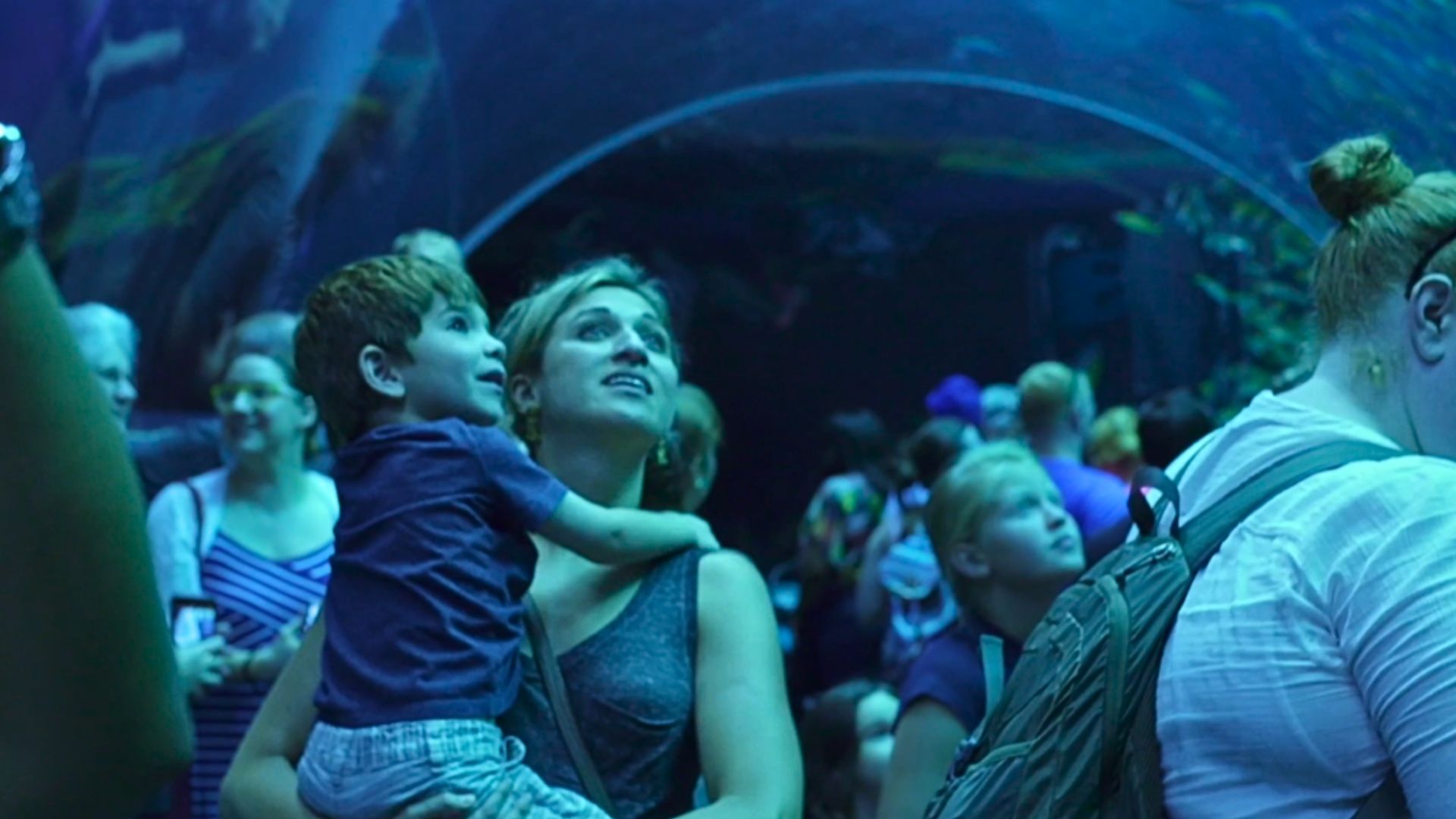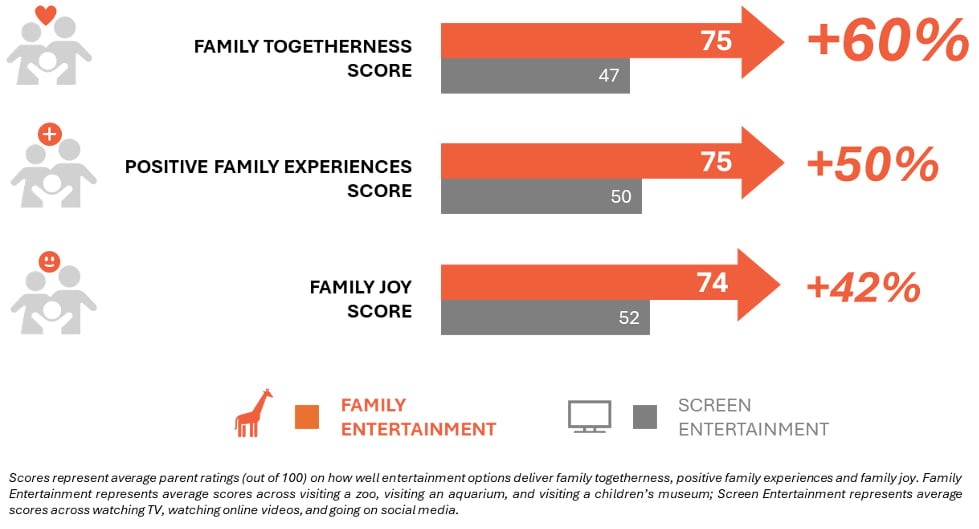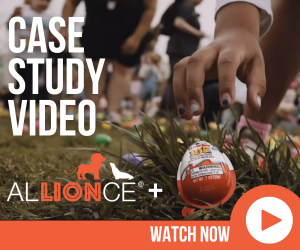
- September 16, 2024
How Brands Can Build Emotional Connections with Parents & Kids at Scale
By
 Exploring centralized family entertainment venues to nurture shared experiences
Exploring centralized family entertainment venues to nurture shared experiences
Parents, especially those with young kids, are among the most challenging consumer cohorts to reach. Today’s parents are time-starved, overscheduled and often feel like their attention is being pulled in too many directions. While children under 18 and their parents account for 41% of the U.S. population, breaking through to this audience seems to be getting increasingly difficult for brands.
As it turns out, the most powerful way to connect is by being part of those in-real-time family entertainment experiences that parents and children have together.
A recent quantitative study conducted by family insights specialist firm Smarty Pants compares how parents of kids ages 2 to 12 score family experiences relative to their screen time activities. The result: Parents give going to zoos, aquariums and museums a 60% higher score than screen-based activities for delivering family togetherness, and a 50% higher score for being a positive family experience.
Historically, the challenge for brands has been identifying how to be part of these moments of wide-eyed wonder and shared family joy, and how to do so at scale. Enter Allionce Group, an independent Boston-based agency that has centralized family entertainment venues like museums, zoos and aquariums to help brands engage meaningfully.
This approach has resonated well for companies like Nickelodeon, Mondelez, General Mills, Quaker and Sun-Maid. They have been particularly drawn to the scale that this national network of family experiences offers—an annual reach of more than 200 million—surpassing all major U.S. sports leagues.
“The most powerful way for brands to connect with families is by being part of their real-life experiences,” said Mark Giovino, Allionce Group CEO. “By embedding brands into the cherished moments parents and children share at these destinations, we not only help create lasting memories but also foster genuine long-term connections that digital interactions simply can’t achieve.”

And, these family outings aren’t just for little kids. The study shows that across children’s ages (from 2 – 12), in-person family entertainment scores consistently higher than screens for togetherness, being a positive family experience and delivering family joy.
Additional key findings from the Smarty Pants study show more specifically that zoos provide:
- 103% more togetherness than social media.
- 81% more positive experiences than social media.
- 73% more joy than social media.
At a time when kids are spending hours per day on screens, being part of moments where they interact with those they love, in places that ignite passions, not only fuels their development but can also spark connections with supporting brands in a way that fosters lifelong memories.
Additionally, these venues offer parents a welcome reprieve from the chaos of everyday life, providing rare moments to see the world through the eyes of their children. As these locations involve shared experiences between parents and their children, Allionce also serves as the largest and most legally compliant way to reach kids ages 2-12, recognizing important considerations around COPPA and KOSA restrictions for marketing to children.
Curating branded experiences that reach multiple generations—including millennial and Gen Z parents, and their Gen Alpha kids—at family entertainment destinations has proven to be an efficient way to drive tangible business outcomes for supporting brand partners.
Omnichannel brand partnerships
Marketing and brand leaders are often surprised to learn how integrated these partnerships can be. One example is Ferrero, one of the world’s largest sweet-packaged food companies and its Kinder Joy brand, which worked with Allionce to create a new strategy to place their brand at the center of Easter family traditions.
 EGGstravaganza, presented by egg-shaped Kinder Joy, offered families the opportunity to celebrate Easter at 30 zoos and aquariums. Easter egg hunts, pictures with the Easter Bunny and self-guided scavenger hunts put families at the center of the experience, and positioning Kinder Joy as the hero of these memorable moments.
EGGstravaganza, presented by egg-shaped Kinder Joy, offered families the opportunity to celebrate Easter at 30 zoos and aquariums. Easter egg hunts, pictures with the Easter Bunny and self-guided scavenger hunts put families at the center of the experience, and positioning Kinder Joy as the hero of these memorable moments.
These celebrations were promoted through moments-based media, leveraging zoo and aquarium media relationships to drive earned media, and positioning these local events as can’t-miss family-friendly Easter celebrations.
This omnichannel approach across sponsorship, media, experiential, and PR led to a 92.5% purchase intent among non-buyers of Kinder Joy.
“Young families are a coveted audience for many brands,” said Todd Midura, former VP of marketing at Ferrero. “The challenge is consistently reaching them. For one, they tend to be very busy people, so they have less time to allocate to media consumption. Furthermore, when they do get a spare minute to watch something, it’s increasingly likely to be happening in an ad-free environment. That’s what makes experiential an interesting option.”
Many of the traditional venues like theme parks, concerts and sporting events are already crowded with brand messages, Midura noted. Zoos and aquariums, however, offer a relatively uncluttered environment to connect with these consumers, while still delivering impressive reach.
Depth of brand connections
The impact of programs like Kinder Joy’s EGGstravaganza event on long-term brand relationships is supported by neuroscience and cognitive psychology principles on how the human brain processes information and stores memories. In essence, brains are wired for experiential impact, and multisensory experiences are more likely to be embedded as long-term memories.
Including family entertainment experiences in marketing plans enables a brand to be experienced in an active manner and encoded along with memories, aiding in recall, as the reasoning goes.
Helping parents reclaim quality time with their children and support their development deepens parents’ positive associations with your brand. “Hands-on, in-person, real world experiences offer a unique opportunity for children to learn and grow,” said Michelle Poris, a developmental psychologist and VP at Smarty Pants. “At-family entertainment venues, the organic face-to-face interactions that families have with each other and other patrons promote positive socio-emotional development.”
In-person and real-time family entertainment options, like zoos, aquariums, and children’s museums, offer a rare opportunity for brands to connect with families on a deeper level. These environments foster stronger bonds and more memorable experiences, creating a direct link to heightened family joy—something that social media, TV and other forms of entertainment can’t compete with. Brands that engage in these shared moments can nurture brand love that will last a lifetime.
